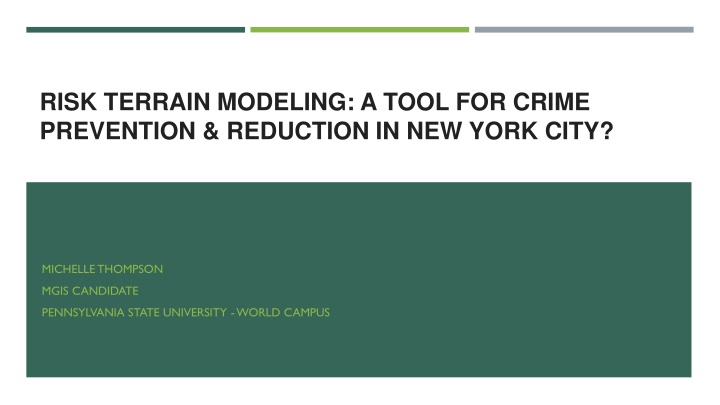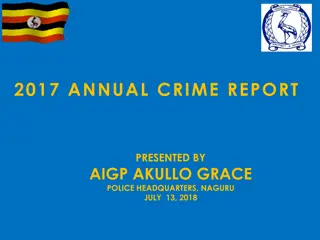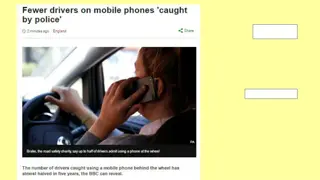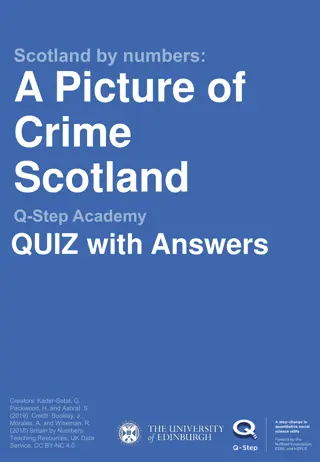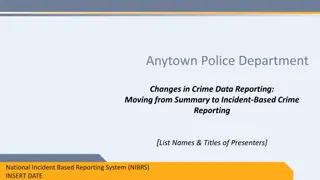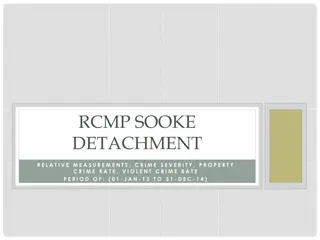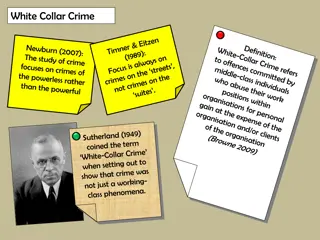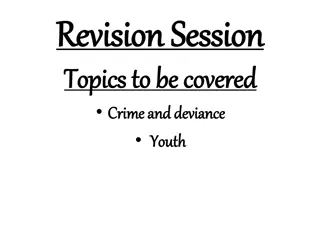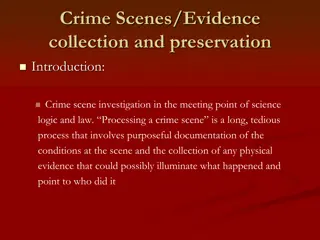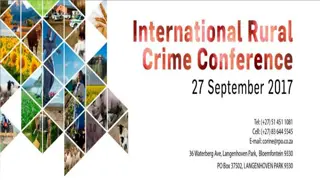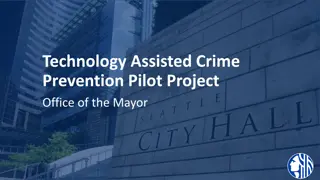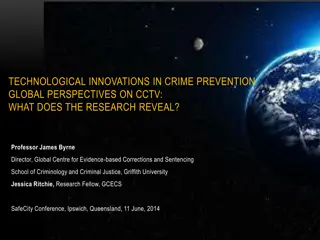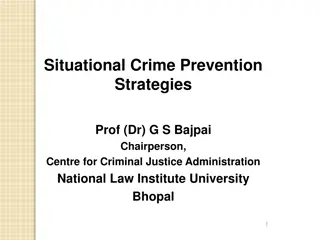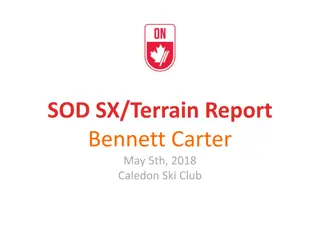Risk Terrain Modeling for Crime Prevention in New York City
Risk Terrain Modeling (RTM) is a spatial risk analysis tool used to identify and model crime risks based on landscape features, helping inform policing strategies. Explore its utility, relevant theoretical background, past applications, risk factors, and methodology in the context of crime prevention in New York City.
Download Presentation

Please find below an Image/Link to download the presentation.
The content on the website is provided AS IS for your information and personal use only. It may not be sold, licensed, or shared on other websites without obtaining consent from the author.If you encounter any issues during the download, it is possible that the publisher has removed the file from their server.
You are allowed to download the files provided on this website for personal or commercial use, subject to the condition that they are used lawfully. All files are the property of their respective owners.
The content on the website is provided AS IS for your information and personal use only. It may not be sold, licensed, or shared on other websites without obtaining consent from the author.
E N D
Presentation Transcript
RISK TERRAIN MODELING: A TOOL FOR CRIME PREVENTION & REDUCTION IN NEW YORK CITY? MICHELLE THOMPSON MGIS CANDIDATE PENNSYLVANIA STATE UNIVERSITY -WORLD CAMPUS
INTRODUCTION OVERALL PURPOSE Explore the utility of Risk Terrain Modeling for understanding the spatial variation in crime rates and informing policing strategies.
RISK TERRAIN MODELING Risk Terrain Modeling, an approach to spatial risk analysis...is used to identify risks that come from features of a landscape and model how they co-locate to create unique behavior settings for crime (Kennedy & Caplan, Rutgers University).
RELEVANT THEORETICAL BACKGROUND Routine Activities: everyone has their daily routine activities and in the course of those activities, the paths of offenders and victims do cross. Crime Pattern Theory: majority of crimes occur in a minority of areas. There is a pattern to crime occurrences, and at certain times and in certain places the co-location of necessary crime elements are more likely to occur.
LIT REVIEW SUMMARY Previous use of RTM include:Newark, NJ;Kansas City, MO; and Chicago, IL Environmental and sociodemographic factors influence future risk of the occurrence of certain types of criminal events Research results = basis for a "risk-based" approach to policing Several factors associated with the increased likelihood for each crime, but specific factors vary by crime type.
RISK FACTORS AND THEIR SPATIAL INFLUENCE Burglary Robbery Aggravated Assault (Felony Assault) Public Housing Developments 300ft Night Clubs 462ft Drug Dealing locations 924ft Banks 1386ft Liquor Stores 864 ft Pawn Shops between 300 and 900ft Bus stops 1728 ft Locations of public High Schools 216 ft Bus stops between 300 and 900ft
METHODOLOGY DATA SOURCES Crime Data: NYPD Complaint Data Current YTD Bus Stops: NYU'S Spatial Data Repository Pawn shops, night clubs, banks, liquor stores - Legally Operating Businesses and RefUSA Public High Schools School Point Locations (updated 2014) Public Housing Locations Map of NYCHA Developments Drug Crime Locations NYPD Complaint Data Current YTD
METHODOLOGY GIS TOOLS AND APPLICATIONS Raster Analysis Converting buffer vector files to raster files Vector Geoprocessing Adding data to ArcMap & Setting up the processing environment Using Raster Calculator to create the overall risk terrain surface Geocoding point datasets and merging necessary features Converting Raster layer back to vector shapefiles Buffering
METHODOLOGY GIS TOOLS AND APPLICATIONS Combining Vector Risk Terrain & Crime Data Spatial Join of risk area polygons to crime rate micro- place grid Crime rate = crime count divided by the micro-place population density
RESULTS AGGRAVATED ASSAULTS (FELONY ASSAULTS) The spatial influence of bus stops had a statistically significant impact on the aggravated assault rate.
RESULTS - BURGLARIES The spatial influence of public housing had a statistically significant impact on the burglary rate.
RESULTS - ROBBERIES The spatial influence of drug crime locations had a statistically significant impact on the robbery rate.
LESSONS LEARNED & FUTURE RESEARCH Lessons Learned Is RTM applicable in NYC? Yes, with some careful forethought Only 3 risk factors chosen Looks at crime data for a whole year; perhaps a quarterly study would produce different results Future Research Explore aggravating and mitigating factors Explore areas outside of the urban environment (i.e. including Staten Island and other parts of the tri-state area)
THANK YOU! Questions/Comments/Concerns?
REFERENCES Caplan et al. 2014 https://crimemapping.info/article/risk-terrain-modeling-strategic-tactical-action/ Caplan and Kennedy, n.d. Risk Terrain Modeling Compendium Caplan and Kennedy 2012 A theory of risky places. Retrieved from http://www.rutgerscps.org/uploads/2/7/3/7/27370595/risktheorybrief_web.pdf Drucker, J. (2011, Mar). Risk factors of aggravated assault. RTM Insights Drawve, G. and Barnum, J. D. (2017). Place-based risk factors for aggravated assault across police divisions in Little Rock, Arkansas. Journal of Crime and Justice. Eversley, M. (2017, Jan. 4) NYC sees historic drop in crime. Retrieved from https://www.usatoday.com/story/news/2017/01/04/nyc-sees-historic-drop-crime/96179104/ Gaziarifoglu, Y. (2010, October). Risk factors of street robbery. Retrieved from http://www.rutgerscps.org/uploads/2/7/3/7/27370595/robberyrisks.pdf Kennedy, L. W. (2015, October). Crime prediction using risk terrain modeling: Thinking spatially about crime and behavior settings. Retrieved from http://www.crime-prevention- intl.org/fileadmin/user_upload/Evenements/Observatory_meeting_2015/Les_Kennedy.pdf Moreto, W. D. (2010). Applying risk terrain modeling to urban residential burglary in Newark, NJ. Retrieved from http://www.rutgerscps.org/uploads/2/7/3/7/27370595/burglaryrtm_casestudy_brief.pdf NYPD (n.d.) Seven major felony offenses. Retrieved from http://www.nyc.gov/html/nypd/downloads/pdf/analysis_and_planning/seven_major_felony_offenses_2000_2015.pdf Pollak, M. (2006, Sept. 17). Knowing the distance. Retrieved from http://www.nytimes.com/2006/09/17/nyregion/thecity/17fyi.html?_r=0 Rutgers Center on Public Security. (2014). Risk terrain modeling: A case study of robbery in Kansas City, MO. Retrieved from http://www.riskterrainmodeling.com/uploads/2/6/2/0/26205659/kcpd_robberyrtmbrief.pdf SimplyAnalytics (2017). Map with 2016 population data. Retrieved from SimplyAnalytics database. Sytsma, V. (2011, May). A pilot application of Risk Terrain Modeling: Aggravated assault in Newark, NJ. Retrieved from http://www.rutgerscps.org/uploads/2/7/3/7/27370595/aggassaultrtm_casestudy_brief.pdf Toomey, M. and Kennedy, L.W. (2011, Apr. 29). An analysis of modern early warning systems: How might Risk-Terrain Modeling contribute to the development of an optimal system? Retrieved from http://www.rutgerscps.org/uploads/2/7/3/7/27370595/earlywarningsystems_workingpaper.pdf Weisburd, D., Groff, E. R., and Yang, S. (2014). The importance of both opportunity and social disorganization theory in a future research agenda to advance criminological theory and crime prevention at places. The Journal of Research in Crime and Delinquency, 5(4), 499-508.
